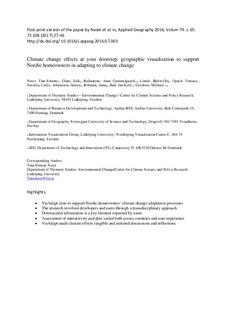| dc.contributor.author | Neset, Tina-Simone | |
| dc.contributor.author | Glaas, Erik | |
| dc.contributor.author | Ballantyne, Anne Gammelgaard | |
| dc.contributor.author | Linnér, Björn-Ola | |
| dc.contributor.author | Opach, Tomasz | |
| dc.contributor.author | Navarra, Carlo | |
| dc.contributor.author | Johansson, Jimmy | |
| dc.contributor.author | Bohman, Anna | |
| dc.contributor.author | Rød, Jan Ketil | |
| dc.contributor.author | Goodsite, Michael Evan | |
| dc.date.accessioned | 2017-12-14T09:34:26Z | |
| dc.date.available | 2017-12-14T09:34:26Z | |
| dc.date.created | 2016-07-08T20:49:11Z | |
| dc.date.issued | 2016 | |
| dc.identifier.citation | Applied Geography. 2016, 74 65-72. | nb_NO |
| dc.identifier.issn | 0143-6228 | |
| dc.identifier.uri | http://hdl.handle.net/11250/2471601 | |
| dc.description.abstract | The complexity of climate information, particularly as related to climate scenarios, impacts, and action alternatives, poses significant challenges for science communication. This study presents a geographic visualization approach involving lay audiences to address these challenges. VisAdapt™ is a web-based visualization tool designed to improve Nordic homeowners' understanding of climate change vulnerability and to support their adaptive actions. VisAdapt is structured to enable individual users to explore several climate change impact parameters, including temperature and precipitation, for their locations and to find information on specific adaptation measures for their house types and locations. The process of testing the tool included a focus group study with homeowners in Norway, Denmark, and Sweden to assess key Challenges in geographic visualization, such as the level of interactivity and information. The paper concludes that geographic visualization tools can support homeowners' climate adaptation processes, but that certain features, such as downscaled climate information are a key element expected by users. Although the assessment of interactivity and data varied both across countries and user experience, a general conclusion is that a geographic visualization tool, like VisAdapt, can make climate change effects and adaptation alternatives tangible and initiate discussions and collaborative reflections. | nb_NO |
| dc.language.iso | eng | nb_NO |
| dc.publisher | Elsevier | nb_NO |
| dc.rights | Attribution-NonCommercial-NoDerivatives 4.0 Internasjonal | * |
| dc.rights.uri | http://creativecommons.org/licenses/by-nc-nd/4.0/deed.no | * |
| dc.title | Climate change effects at your doorstep: Geographic visualization to support Nordic homeowners in adapting to climate change | nb_NO |
| dc.type | Journal article | nb_NO |
| dc.type | Peer reviewed | nb_NO |
| dc.description.version | acceptedVersion | nb_NO |
| dc.source.pagenumber | 65-72 | nb_NO |
| dc.source.volume | 74 | nb_NO |
| dc.source.journal | Applied Geography | nb_NO |
| dc.identifier.doi | 10.1016/j.apgeog.2016.07.003 | |
| dc.identifier.cristin | 1367065 | |
| dc.relation.project | Norges forskningsråd: 235490 | nb_NO |
| dc.description.localcode | This is the authors' accepted and refereed manuscript to the article. Locked until 15 July 2018 due to copyright restrictions. | nb_NO |
| cristin.unitcode | 194,67,10,0 | |
| cristin.unitname | Institutt for geografi | |
| cristin.ispublished | true | |
| cristin.fulltext | postprint | |
| cristin.qualitycode | 1 | |

